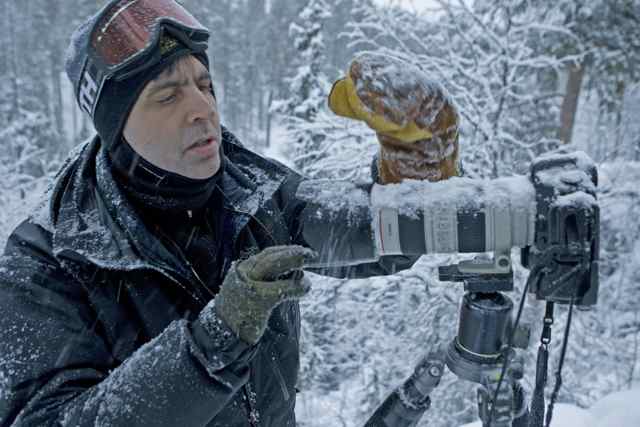Gaines Lecture Series
JOHN B. GAINES FAMILY LECTURE SERIES
Peter Essick (2014)

Executive Summary
Western Kentucky University's School of Journalism & Broadcasting will mark the 10th anniversary of the John B. Gaines Family Lecture Series with guest lecturer Peter Essick, who has photographed 40 stories for National Geographic magazine. The free event is scheduled for 7:30 p.m. Thursday, Feb. 27, in Mass Media & Technology Hall (MMTH) auditorium on WKU's campus.
Essick will offer a perspective on the importance of environmental journalism as well as background details on the images he has taken while on assignment for National Geographic magazine, said Loup Langton, director of the School.
In addition to the lecture, two of Essick's photography exhibits are now on display in MMTH and will be available through Friday, March 21. "Our Beautiful, Fragile World," the images to be included in his February lecture, is located in the MMTH atrium. The exhibit documents contemporary environmental issues, such as climate change and nuclear waste. "Ansel Adams Wilderness," located in the MMTH gallery, is Essick's tribute to Ansel Adams and the craggy Sierra Nevada wilderness named in Adams' honor.
"Through the generous gift of the John B. Gaines family, WKU has benefitted from a decade of exceptional guest lecturers who have shared their numerous professional experiences with our students," said David Lee, dean of WKU's Potter College of Arts and Letters. "Peter Essick and his contributions to environmental journalism will certainly continue that strong tradition."
Recently named one of the 40 most influential nature photographers in the world by Outdoor Photography, Essick (peteressick.com) has photographed natural areas from around the world, portraying both the human impact of development as well as the enduring power of the land through his photographs.
"Having known Peter for almost 30 years, I'm certain that his presentation on visually documenting a host of global environmental developments will fascinate and stimulate thinking among students, faculty and guests." said Langton. "These are issues important to all of us."
During the past 25 years, Essick's contributions to National Geographic magazine have focused on a variety of environmental issues, including inner Japan, the American wilderness, the carbon cycle, global warming, and global freshwater. Recent stories include a June 2010 cover story on Greenland, "The Ansel Adams Wilderness" in October 2011, and "Fertilizing the World" in May 2013.
About the John B. Gaines Family Lecture Series
The John B. Gaines Family Lecture Series, launched in 2004 in honor of the 150th anniversary of the Gaines' family-owned newspaper, the Daily News, has brought several award-winning international journalists to WKU. Previous lecture participants include Washington Bureau Chief for the Dallas Morning News Todd Gillman; investigative freelance journalist Lucy Komisar; newspaper journalism icon John Seigenthaler; Emmy award-winning photojournalist Dai Sugano of the San Jose Mercury News; Pulitzer Prize-winning columnist Leonard Pitts of The Miami Herald; New Orleans Times-Picayune staff writer Mark Schleifstein; and Chicago Tribune photojournalist and official White House photographer Pete Souza.
For more information on the John B. Gaines Family Lecture Series, contact the WKU School of Journalism & Broadcasting at (270) 745-4144.
Past Speakers
Student photojournalists at WKU are discussing the impact of the work done by the
lecturer, Peter Essick, and why he excels at what he does.
Essick has completed some photography work along the similar path of Ansel Adams, and the use of Adams as a starting point along with putting his own personal spin on the project is something WKU photojournalist Justin Philalack said is notable of Essick's work.
"I really enjoy his work in the sense that it really takes us to different dimensions," Philalack said. "I think that's what makes him, just that drive, that passion, and I think that's very inspiring."
Justin Gilliland, also a photojournalist at WKU, said Essick's work is essential in that it helps illustrate what is happening in the world around us in a more efficient way than simply trying to grasp it through text.
"He's been able to go out there and see it and display it for us," Gilliland said. "It's really a bigger impact than what you could just read."
Gilliland said that what makes Essick a top photographer is his ability to craft what he sees into something more visible to the untrained eye. He said by doing that, Essick helps to make the situations around us seem more real.
"I think being able to make beautiful pictures from the environment and get a message to people without having that really robust, human emotion," Gilliland said. "I think it's a tough thing to do."
WKU photojournalist Cassidy Johnson agreed in Essick's ability to convey the larger picture of our surroundings throughout the world. She said his photos show all the events proceeding around us, but more importantly show what is necessary; what is happening to the environment.
"He shows people how beautiful our environment is but also what we're doing to it that is hurting it," Johnson said.
Through Essick's work with the environment and by taking photographs of the actual world we live in, his impact can be seen by those who have studied his pictures.
"He is expressing reality and what people really need to see," Gilliland said. "Which is something beyond who he is, and it makes it a little more universal."








 “I see my work as a hybrid of landscape photography, outdoor work, and traditional
journalism.”
“I see my work as a hybrid of landscape photography, outdoor work, and traditional
journalism.”